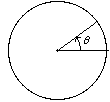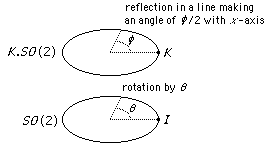Proof
Look at the effect of applying an element of SO(2) to the standard basis.

Remark
 We can consider SO(2) as (say) a unit circle in C by identifying the rotation by an angle θ with the complex number eθ i.
We can consider SO(2) as (say) a unit circle in C by identifying the rotation by an angle θ with the complex number eθ i.
Proof
As above, look at the effect of applying an element of O(2) to the standard basis.

Remarks
- The rotations in O(2) correspond to matrices with determinant +1, while the reflections correspond to those elements with determinant -1. Because the product of two matrices with determinant -1 has determinant +1, it follows that composing two reflections gives us a rotation.

- We can think of O(2) as a union of two circles, one corresponding to the rotations which are in SO(2) as above, and the other corresponding to the angle the "mirror" line makes with some fixed direction.
Proof
[This result is non-trivial. In particular it is not obvious that the product of two rotations about lines in R3 is a rotation about some line in R3 and indeed, given two such rotations, it can be hard to spot which line their composite rotates around. The proof involves some linear algebra theory.]
First note that for any matrix, the determinant is the product of the eigenvalues. To see this, reduce the matrix A to row-echelon form R using a change of basis. Then R = BAB-1 with B the change of basis matrix. Then det(A) = det(R) and the entries on the diagonal of R are the eigenvalues.
Any 3 × 3 matrix has a real eigenvalue λ since the polynomial you have to solve to find the eigenvalues is a cubic and any cubic has a real root.
Since the transformation is length preserving we must have λ = ±1.
If the other eigenvalues are real too, they must also be ±1 and since their product is +1, one of the eigenvalues is +1.
If the other eigenvalues are non-real, they are complex conjugate to one another and so their product is positive. So the real eigenvalue is +1.
Thus in either case, the transformation T has a fixed vector a with T(a) = +1a. (This is called an axis.)
In the plane perpendicular to a, vectors in this plane are mapped into this plane (since angles are preserved) and so the transformation acts like an element of SO(2) and it is therefore rotation by some angle about the axis a.

Remark
One may get a "picture" of SO(3) as follows.
Represent a rotation by an angle θ (radians) about a unit vector a by a vector of length θ in the direction of a.
Then every rotation is represented by a unique point in a solid ball of radius π (except that since rotation by π about a is the same as rotation by π about -a, one must "identify" opposite points on the boundary of the ball).
Proof
See Exercises 2 Question 1

Remark
Note that the different cases can be separated by their fixed point sets (points for which T(x) = x).
- A rotation has a 1-dimensional fixed point set (a line),
- A reflection has a 2-dimensional fixed point set (a plane),
- A rotatory reflection has a 0-dimensional fixed point set (a point).